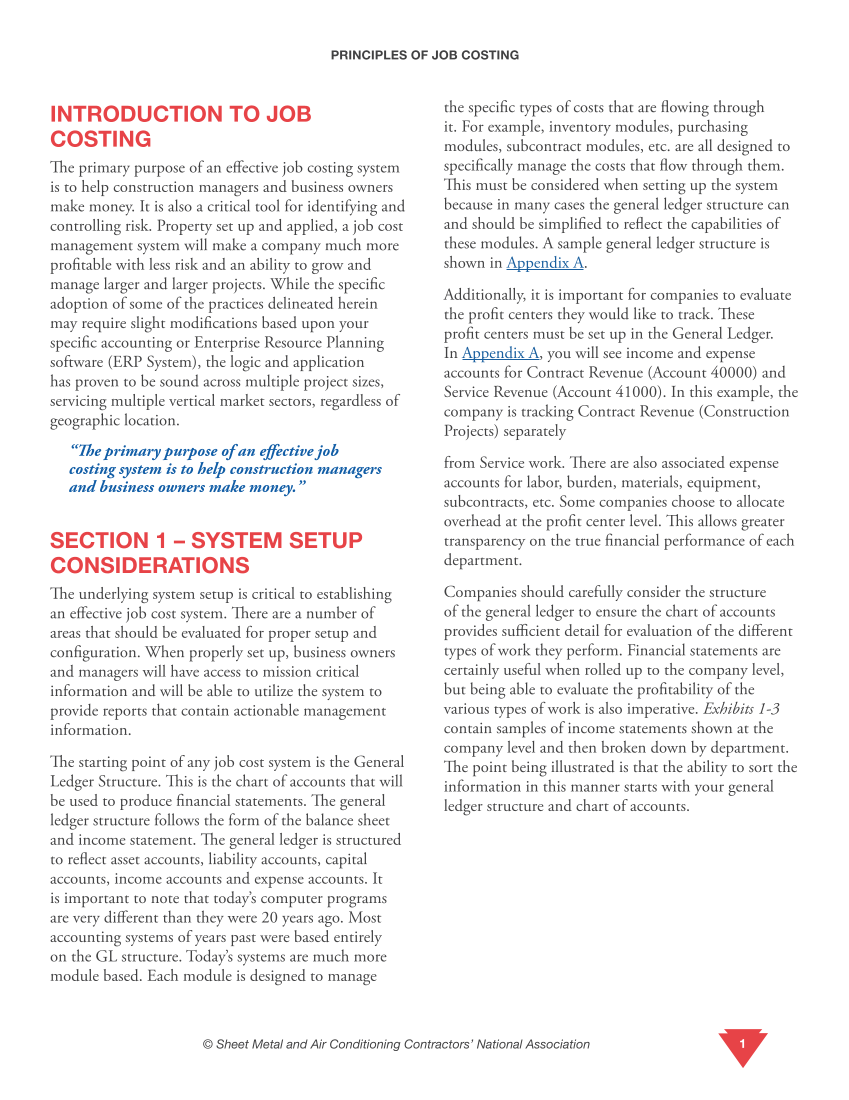PRINCIPLES OF JOB COSTING © Sheet Metal and Air Conditioning Contractors’ National Association 1 INTRODUCTION TO JOB COSTING The primary purpose of an effective job costing system is to help construction managers and business owners make money. It is also a critical tool for identifying and controlling risk. Property set up and applied, a job cost management system will make a company much more profitable with less risk and an ability to grow and manage larger and larger projects. While the specific adoption of some of the practices delineated herein may require slight modifications based upon your specific accounting or Enterprise Resource Planning software (ERP System), the logic and application has proven to be sound across multiple project sizes, servicing multiple vertical market sectors, regardless of geographic location. “The primary purpose of an effective job costing system is to help construction managers and business owners make money.” SECTION 1 – SYSTEM SETUP CONSIDERATIONS The underlying system setup is critical to establishing an effective job cost system. There are a number of areas that should be evaluated for proper setup and configuration. When properly set up, business owners and managers will have access to mission critical information and will be able to utilize the system to provide reports that contain actionable management information. The starting point of any job cost system is the General Ledger Structure. This is the chart of accounts that will be used to produce financial statements. The general ledger structure follows the form of the balance sheet and income statement. The general ledger is structured to reflect asset accounts, liability accounts, capital accounts, income accounts and expense accounts. It is important to note that today’s computer programs are very different than they were 20 years ago. Most accounting systems of years past were based entirely on the GL structure. Today’s systems are much more module based. Each module is designed to manage the specific types of costs that are flowing through it. For example, inventory modules, purchasing modules, subcontract modules, etc. are all designed to specifically manage the costs that flow through them. This must be considered when setting up the system because in many cases the general ledger structure can and should be simplified to reflect the capabilities of these modules. A sample general ledger structure is shown in Appendix A. Additionally, it is important for companies to evaluate the profit centers they would like to track. These profit centers must be set up in the General Ledger. In Appendix A, you will see income and expense accounts for Contract Revenue (Account 40000) and Service Revenue (Account 41000). In this example, the company is tracking Contract Revenue (Construction Projects) separately from Service work. There are also associated expense accounts for labor, burden, materials, equipment, subcontracts, etc. Some companies choose to allocate overhead at the profit center level. This allows greater transparency on the true financial performance of each department. Companies should carefully consider the structure of the general ledger to ensure the chart of accounts provides sufficient detail for evaluation of the different types of work they perform. Financial statements are certainly useful when rolled up to the company level, but being able to evaluate the profitability of the various types of work is also imperative. Exhibits 1-3 contain samples of income statements shown at the company level and then broken down by department. The point being illustrated is that the ability to sort the information in this manner starts with your general ledger structure and chart of accounts.
Licensed for the exclusive use of . (). Any use by others is in violation of SMACNA's copyright. Downloaded 4/20/24, 3:31 AM UTC. © SMACNA. All Rights Reserved. Contact: info@smacna.org
